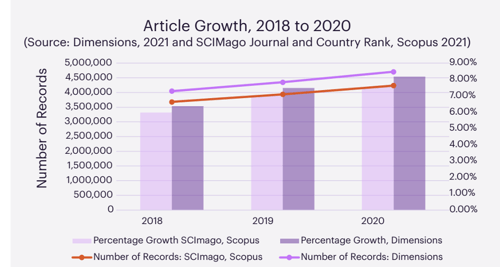From 2018 to 2020, the volume of articles on SCImago and Dimensions grew by over one million records.

How can Medical Affairs stay ahead of this growing volume of biomedical literature?
How can technology help streamline manual processes, capture insights, and demonstrate value?
In this article, we share 3 ways to capture more insights from biomedical literature and streamline workflows across Medical Affairs.
Let’s dive in.
The Role of Biomedical Literature in Medical Affairs
In Medical Affairs, the value of biomedical literature cannot be understated.
In Field Medical
MSL leads and Medical Directors must track their disease area, so teams monitor literature to provide updates and reports that drive action.
In Pharmacovigilance
Pharmacovigilance experts must monitor publications for product mentions and adverse events. If a key piece of information gets missed, it creates tremendous risk.
In Market Access
On the market access side, teams are focusing on guidelines and clinical pathways within the literature ecosystem to look out for product mentions. In context, teams can see how the product is being talked about and if that is consistent with new data releases or the existing label.
🎙Tune into our recent on-demand webinar - Streamlining Medical Literature Monitoring - to dive deeper into the ways Intelligent Publication Monitoring is helping to ease the manual review burden.
Although the use cases may vary, teams across Medical Affairs are experiencing similar challenges when it comes to staying ahead.
What are 3 challenges facing Medical Affairs today?
Challenge #1: Rising Volumes of Literature
The volume of biomedical literature is growing at an exponential rate. Many teams remain the same size, while still being responsible for processing this data in a set timeframe. It’s increasingly difficult to extract critical information at the same pace.
Challenge #2: Data Silos
It is difficult and time-consuming to track multiple databases and repositories at the same time, yet this is often an important way to ensure your Medical Affairs team is capturing the entire landscape. By tracking information in diverse streams of channels without a clear way to bring it all together, it can create data gaps.
Challenge #3: Tools to Process Complex Biomedical Language
Especially in an innovative space, like healthcare and life sciences, new terms and concepts come out on a regular basis. It is challenging to maintain standard search queries to ensure that your team is capturing relevant, critical data and not missing anything.
Today, artificial intelligence (AI) can address these problems and ease the manual review burden for Medical Affairs. But how?
3 Ways to Capture Insights from Biomedical Literature with Intelligent Publication Monitoring (IPM)
1. Unlock Data from Unstructured Content, such as PDFs
There are many advantages to PDFs. Today, however, this leads to millions of articles containing data locked away within unstructured text.
For life sciences, this invaluable data could be utilized to improve health outcomes.
Artificial intelligence is now unlocking access to this data. Medical Affairs can upload or integrate PDFs from databases, such as PubMed, into Intelligent Publication Monitoring (IPM).
The text from the PDFs is processed and enriched so that it can be analyzed in context.

This can make it easier to search for and identify critical, relevant information. Why?
Today, research content is spread across many websites. On each website, not all queries are the same. If your team has a set query for PubMed, it’s likely not the same as Europe PMC or clinicaltrials.gov.
By unifying each of these sources into one place, IPM is lifting the manual search burden. It crawls through all of this data, across millions of abstracts daily, to bring back the most relevant content for you.
How does this process work?
In this on-demand webinar, “Applying AI to Medical Affairs: Streamlining Medical Literature Monitoring,” our Sorcero team dives deeper into how it works. Watch it here.
2. Uncover Insights from Medical Literature - In Context
We’re living in a digital revolution. Big data is here.
But, when it comes to extracting data from biomedical content, there are massive opportunities to explore - even in singular abstracts.
For example, in a Sorcero use case, a life sciences enterprise uses Intelligent Publication Monitoring to pull out therapeutic area, disease state, patient population, and other key information that would usually need to be found manually.
This information can now be used as data points.
Medical Affairs experts can use these data points to identify and evaluate trends. When this is applied to 1000s of articles, we can uncover key patterns in the literature and connect those to other data and sources of insights.
With IPM, Medical Affairs can not only get a clear view of a therapeutic area, but begin to segment data to key thematic areas. This takes teams beyond traditional tracking for keywords or key mentions.
IPM does accelerate manual processing, but it also enables Medical Affairs to ask: What is now possible from a medical intelligence perspective? What can we do with these new layers of data at our fingertips?
3. Accelerate Decision-Making, Improve Accessibility, & Share Key Findings with Auto-Summarization
Once key information or data is extracted from biomedical literature, whether manually or with the assistance of IPM, it’s usually placed into a report. Rather than dropping in a long abstract, it is generally ideal to call out the most important points.
Today, artificial intelligence can generate summaries of this complex content to pull out the most important information. These summaries can serve several purposes.
💡Get the Guide: A Guide to Summarizing Medical Documents with AI
For the expert monitoring the literature, an AI summary can help them quickly identify if they should dedicate time evaluating a certain article. Experts can also take these summaries and use them to build reports or presentations.
With these intuitive reports in hand, Medical Affairs leadership can drive strategy, share findings, and demonstrate value.
.gif?width=600&name=Product%20Video%20(4).gif)
Using IPM, Medical Affairs can pool literature across internal and external sources, generate biomedical document summaries, and export this information to a PDF or PowerPoint that can be shared with teams and stakeholders.
This also makes it easier to generate accessible content, so that enterprises can focus on the points that matter most and improve outcomes.
Applying AI to Medical Affairs - Streamlining Medical Literature Monitoring
Today, there’s an unprecedented need in Life Sciences to sort information from insights that influence outcomes.
At Sorcero, we help Medical Affairs focus on what these insights actually mean.
In our Digital Clarity webinar series, you can join us to discover use cases and best practices for utilizing the latest artificial intelligence and analytics solutions in Medical Affairs.
In this on-demand webinar, you'll learn:
- Opportunities for Publication Monitoring: New ways to streamline publication monitoring workflows across Medical Affairs
- How to Apply AI to Biomedical Literature: How artificial intelligence can help ease the manual review burden
- Put it into Practice: Actionable steps for applying AI to publication monitoring with Intelligent Publication Monitoring (IPM)
%20(13).png?width=300&name=Blog%20Headers%20(1200%20%C3%97%20600%20px)%20(13).png)

